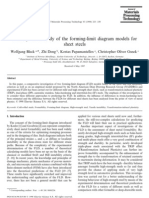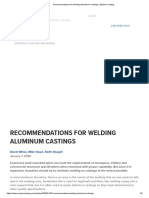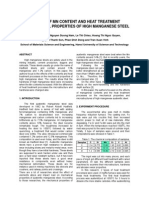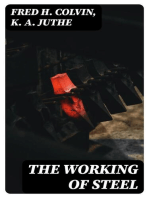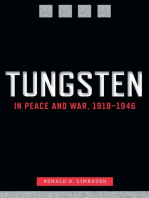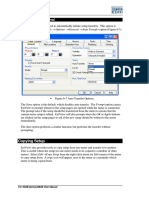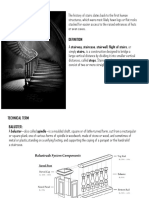The Use of Titanium in Family Automobiles: Current Trends: K. Faller and F.H. (Sam) Froes
The Use of Titanium in Family Automobiles: Current Trends: K. Faller and F.H. (Sam) Froes
Uploaded by
Amol HawaldarCopyright:
Available Formats
The Use of Titanium in Family Automobiles: Current Trends: K. Faller and F.H. (Sam) Froes
The Use of Titanium in Family Automobiles: Current Trends: K. Faller and F.H. (Sam) Froes
Uploaded by
Amol HawaldarOriginal Title
Copyright
Available Formats
Share this document
Did you find this document useful?
Is this content inappropriate?
Copyright:
Available Formats
The Use of Titanium in Family Automobiles: Current Trends: K. Faller and F.H. (Sam) Froes
The Use of Titanium in Family Automobiles: Current Trends: K. Faller and F.H. (Sam) Froes
Uploaded by
Amol HawaldarCopyright:
Available Formats
Titanium Overview
The Use of Titanium in Family Automobiles: Current Trends
K. Faller and F.H. (Sam) Froes
Titanium offers a number of attractive features for use in high-production-volume automobiles; however, to date, high cost has been a barrier to application. This article discusses the current trends for the use of titanium in the family automobile, with emphasis on two breakthrough applications. INTRODUCTION The attractive characteristics (e.g., high strength, low density, and excellent corrosion resistance) of titanium offer many potential applications in automobiles both in the drive train and in the chassis.15 In these applications, titanium offers the potential for weight reduction and, perhaps, performance improvements, when substituted for alloys or stainless steels. Weight reduction, because it provides greater design flexibility, is important for both racing and high-volume family automobiles.4 For a number of years, race-car engine builders have chosen titanium for reduced-weight valves and connecting rods. Performance improvements resulted from torque and power output and reduced deflection of associated components.1 In passenger cars, the benefits of titanium would include fuel economy (due to improved power-train efficiency or vehicle weight reduction),35 reduced engine noise and vibration, and imTable I. Cost of Titanium A Comparison* Item Material ($ per pound) Steel Aluminum Titanium Ore 0.02 0.10 0.30 Metal 0.10 0.68 2.00 Ingot 0.15 0.70 4.50 Sheet 0.300.60 1.005.00 15.0050.00
* Thus the high cost of titanium compared to aluminum and steel is a result of (a) high extraction costs and (b) high processing costs. The latter relating to the relatively low processing temperatures used for titanium and the conditioning (surface regions contaminated at the processing temperatures, and surface cracks, both of which must be removed) required prior to further fabrication.
Fuel Economy (Mileage/gl)
Passenger Vehicles in Japan 60 50 40 30 20 10 0 1,000
2,000
3,000 4,000 Vehicle Weight (lb)
5,000
Figure 2. Effect of weight reduction on fuel consumption.
proved durability due to reduced component loads. Passenger automobile components that could benefit from titanium include engine valves, connecting rods and valve-spring retainers, and valve springs (Figure 1).6 The effect of automobile weight on fuel consumption is shown in Figure 2. Non-engine applications in the automobile also exist for titanium. Use of titanium in the chassis, for instance, would reduce the vehicles weight and, as a result, improve its fuel economy. Among the components of greatest interest are coil suspension springs, exhaust systems, half shafts, bolts, and other fasteners. Titanium has been employed for these components in race cars, but until recently applications in family
automobiles had not progressed beyond the prototype stage. Two major obstacles must be overcome if titanium is to be used in high-volume production automotive applications. First, both rawmaterial and component-fabrication costs must be reduced to affordable levels (Table I). Second, an appropriate supply base must be created (i.e., the capabilities of titanium and component suppliers must be expanded to provide the volume of material and products that would be needed). The worldwide titanium market is about 45,000 tonnes per year, with about half in the United States. The total production car market is 60 million vehicles, with slightly more than 25% in the United States. Thus, even 0.5 kg of titanium in 50% of the autos would represent a substantial 30% increase in titanium use. For that reason, the auto use of titanium has often been referred to as the holy grail of the titanium industry. TITANIUM USE IN THE FAMILY AUTOMOBILE The Titanium Metals Corporation (Timet) identifies five keys to acceptance of titanium in automobiles: Provide a real solution. Gain consensus. Leverage technology. Use established manufacturing techniques. Deliver value. The first use of titanium in a production automobile, albeit high end, was for connecting rods in the Acura NSX V-6. This use was followed by titanium valves in the 1998 Japanese car of the year, the Toyota Altezza (Figure 3). With a powder-metallurgy approach, Ti-6Al-4V/TiB is being used for the intake valves on the Altezza, and a high27
Figure 1. Potential applications of titanium in passenger cars.
2001 April JOM
temperature Ti-Al-Zr-Sn-Nb-Mo-Si/TiB composition for the exhaust valves. The engine is 2,000 cc, with eight intake valves and eight exhaust valves. The titanium valves weigh 27 g (intake) and 24 g (exhaust), or 408 g per automobile. The steel valves for the same engine are 44.6 g for the intake valves and 40.0 g for the exhaust valves. The use of titanium also reduces the valve spring weight from 43 g to 36 g. With an initial production rate of 4,000 automobiles per month, half are equipped with the titanium valves. Other applications in Japan include titanium gear shift knobs on Hondas S2000 roadster and the Acura Integra type R. In Europe, Ferrari and Porsche have introduced titanium connecting rods in series production models. The two newest applications of titanium in family autos demonstrate the importance of the five keys to acceptance. For example, in the Corvette Z06 exhaust, the goal was to reduce mass to improve performance. Titanium provided an 11.7 kg dual muffler assembly, achieving a 41% weight reduction and contributing to the best performing Corvette ever with a virtually unlimited exhaust life (Figure 4). Consensus and leverage were achieved by Timet working with Arvin Meritor on a new Timetal Exhaust Grade titanium (similar to Grade 2). The materials were jointly tested to assure performance. Established manufacturing techniques for stainless steel stamping, bending, cold forming and welding were successfully modified for titanium. And, finally, the mass reduc-
tion noted above delivered the desired customer value. Springs are a natural application for titanium because of the metals low modulus and reduced density compared to steel. Although titanium springs are already extensively used in the aerospace industry by companies such as Boeing, Timet felt that the product was much too expensive for automobile use. Thus, the approach has been to develop the titanium auto springs with an aerospace manufacturer and then, along with Volkswagon AG, take the spring to be fabricated by a car producers fabricator using a standard steel spring manufacturing line. VWs selection of fabricator, Muhr und Bender, modified its steel spring manufacturing line to accommodate titanium. The result, using the lowcost beta alloy Ti-4.5Fe-6.8Mo-1.5Al is a material up to 50% less expensive than conventional beta alloys, a spring only one-third the mass of an equivalent steel spring and with optimized fatigue life. The use of these titanium springs on the 2001 model year Volkswagon Lupo FSI contributes to the 81.6 kg overall weight reduction on the FSI model compared to the standard model Lupo. The Lupo FSI is being marketed in Europe as the lowest fuel consumption gasoline car in the world at 48 mpg. Volkswagon expects to manufacture up to 3,500 of the 2001 model year FSI Lupos (Figure 5). FUTURE OPPORTUNITIES
Figure 5. Titanium spring shown in place on the Volkswagon Lupo FSI.
The critical breakthrough appears to have been made in getting titanium into large-volume production automobiles in niche applications. We are clearly not going to see titanium sheet replacing steel sheet with a cost differential of 50100 times (Table I). However, the niche applications already established can be grown through design and production advances, and new niches Figure 3. The Toyota Altezza, 1998 Japanese Car of the Year, can be added. The chalthe first family automobile in the world to feature titanium lenge will be to move valves. beyond the niche status to large-volume applications by reducing cost. Lower cost sponge would be very desirable, but whether the Kroll or Hunter processes (already optimized extensively) can be modified to achieve this is frankly doubtful. The Fray process, 79 however, offers a completely new, albeit still experimental technique with interesting Figure 4. The authors, Froes (left) and Faller (right) are shown potential. Near netlifting the stainless steel and titanium exhaust systems, respecshape powder metaltively. Faller lifts the titanium system with ease; Froes struggles lurgy approaches have with the stainless steel component. 28
proven their potential on the Altezza, and other chunky parts are also amenable to this method. 10 Lower-cost, higher-yield alloys and single-melt (cold hearth electron-beam or plasma) processing can reduce cost, as can the implementation of multi-year price agreements. The titanium industry must also be prepared to use available high-volume steel production equipment and assure auto manufacturers that consistency and quality are not problems. ACKNOWLEDGEMENTS The author (F.H. Froes) acknowledges the assistance of Mrs. Marlane Martonick in typing and formatting this article. References
1. K. Faller and F.H. (Sam) Froes, Materials and Science in Sports, ed. F.H. (Sam) Froes and S. Haake (Warrendale, PA: TMS, 2001), pp. 4756. 2. A.M. Sherman and J.E. Allison (Paper 860608 presented at the SAE Int. Congress and Exposition, Warrendale, PA, 1986). 3. J.E. Allison, A.M. Sherman, and M.R. Bapna, JOM, 39 (2) (1987), pp. 1417. 4. A.M. Sherman, C.J. Sommer, and F.H. Froes, JOM, 49 (5) (1997), p. 38. 5. F.H. Froes, Light Metals Age (February 1999), p. 117. 6. L. Martin (Paper presented at the ITA Conference, New Orleans, LA, October 2000). 7. G.Z. Chen, D.J. Fray, and T.W. Farthing, Nature, 407 (2000), p. 361. 8. Malcolm Ward-Close, Fray Process (Paper presented at the ITA Conference, New Orleans, LA, October 2000). 9. F.H. Froes, Light Metal Age (February 2001), p. 54. 10. V. Moxson and F.H. (Sam) Froes, Materials and Science in Sports, ed. F.H. (Sam) Froes and S. Haake (Warrendale, PA: TMS, 2001), pp. 5770.
K. Faller is with the International Automotive Applications division of TIMET Corporate Development. F.H. (Sam) Froes is with the Institute for Materials and Advanced Processes (IMAP) at the University of Idaho. For more information, contact F.H. Froes, University of Idaho, Institute for Materials and Advanced Processes (IMAP), Mines Building, Room 321B, Moscow, ID 83844-3026; (208) 885-7989; fax (208) 885-4009; e-mail imap@uidaho.edu or Kurt Faller, TIMET Corporate Development, 900 Hemlock Road, Morgantown, PA 19543; (610) 286-1222; fax (610) 286-3831.
JOM April 2001
You might also like
- Super AlloysDocument1 pageSuper AlloysSyed Danish FayazNo ratings yet
- Wire DrawingDocument18 pagesWire DrawingstaniNo ratings yet
- Martensite FormationDocument13 pagesMartensite FormationMatteo1980No ratings yet
- L170R41 eDocument142 pagesL170R41 eJairo Morales100% (2)
- 2 Mark Questions With AnswersDocument3 pages2 Mark Questions With AnswersMonica Purushothaman50% (2)
- Aluminium Alloy Guide and Proof StressDocument2 pagesAluminium Alloy Guide and Proof StressmuniNo ratings yet
- BMP FI-RevA-1-8.xerDocument1,590 pagesBMP FI-RevA-1-8.xerbharathyNo ratings yet
- Diamond Like Amorphous Carbon PDFDocument153 pagesDiamond Like Amorphous Carbon PDFமாத்தி யோசிப்பேன்No ratings yet
- 3.1 Solved Problem Set PDFDocument30 pages3.1 Solved Problem Set PDFmrtcn100% (1)
- FOAMINGOFSLAGSINEAFDocument10 pagesFOAMINGOFSLAGSINEAFJose LaraNo ratings yet
- Processes For Recycling: 4.4.1.2.1 Conventional Kroll ProcessDocument14 pagesProcesses For Recycling: 4.4.1.2.1 Conventional Kroll Processelma watNo ratings yet
- Metal Oxides Semiconductor CeramicsDocument14 pagesMetal Oxides Semiconductor Ceramicsumarasad1100% (1)
- DME Assignment 1Document2 pagesDME Assignment 1sumikannuNo ratings yet
- Review of Magnesium Metal Matrix CompositesDocument19 pagesReview of Magnesium Metal Matrix CompositesGokulraju RangasamyNo ratings yet
- Thermodynamic and Kinetic Aspects of Secondary Steelmaking ProcessesDocument37 pagesThermodynamic and Kinetic Aspects of Secondary Steelmaking ProcessesHASSAN MUSHTAQNo ratings yet
- Basics of Gray Iron Casting DesignDocument9 pagesBasics of Gray Iron Casting DesignVarga TrigustaraNo ratings yet
- Aluminium Alloy Applications PDFDocument3 pagesAluminium Alloy Applications PDFKhanHasibKaisarNo ratings yet
- Weathering of Anodized AluminiumDocument7 pagesWeathering of Anodized AluminiumShahid PerwezNo ratings yet
- Square Cup Deep Drawing Using Forming Limit DiagramDocument16 pagesSquare Cup Deep Drawing Using Forming Limit DiagramDan WolfNo ratings yet
- Technical Transfer Dispatch #6: ULSAB-AVC Body Structure Materials May 2001Document52 pagesTechnical Transfer Dispatch #6: ULSAB-AVC Body Structure Materials May 2001Jony M. TemnikarNo ratings yet
- A Comparative Study of The Forming-Limit Diagram Next Term Models For Sheet SteelsDocument8 pagesA Comparative Study of The Forming-Limit Diagram Next Term Models For Sheet SteelsRaghav KhajuriaNo ratings yet
- Analysis and Die Design of Flat-Die Hot Extrusion Process 2. Numerical Design of Bearing LengthsDocument12 pagesAnalysis and Die Design of Flat-Die Hot Extrusion Process 2. Numerical Design of Bearing LengthsPraveen ChathurangaNo ratings yet
- Practical Data For MetallurgistsDocument37 pagesPractical Data For MetallurgistsmetallurgistNo ratings yet
- PCD Wire Edm Technology PDFDocument6 pagesPCD Wire Edm Technology PDFyorf1989No ratings yet
- Titanium-A New Metal For The Aerospace AgeDocument26 pagesTitanium-A New Metal For The Aerospace AgedouslasNo ratings yet
- A147430 PDFDocument146 pagesA147430 PDFRoman GrantNo ratings yet
- The Behaviour of The Secondary Metallurgy Slag Into The EAF. How To Create A Good Foamy Slag With The Appropriate Basicity Using A Mix of Lime and Recycled Ladle Slag As EAF Slag FormerDocument1 pageThe Behaviour of The Secondary Metallurgy Slag Into The EAF. How To Create A Good Foamy Slag With The Appropriate Basicity Using A Mix of Lime and Recycled Ladle Slag As EAF Slag FormerRavindra Kashyap0% (1)
- Seminar On Machinability ofDocument18 pagesSeminar On Machinability ofkanthiswaroopNo ratings yet
- Aluminium Insight 2011-02 Lomag Mag RemovalDocument1 pageAluminium Insight 2011-02 Lomag Mag Removalnabeel1981No ratings yet
- Additive Manufacturing A Framework For ImplementationDocument8 pagesAdditive Manufacturing A Framework For Implementationnicero555No ratings yet
- Effect of Microstructure and Alloy Contents On The Luders Line Formation in Al-Mg AlloysDocument6 pagesEffect of Microstructure and Alloy Contents On The Luders Line Formation in Al-Mg AlloysJinsoo KimNo ratings yet
- Physical Metallurgy of The Thermo Mechanical ProcessingDocument14 pagesPhysical Metallurgy of The Thermo Mechanical ProcessingpritzelpdfNo ratings yet
- Chip Recycling Brochure-NewDocument2 pagesChip Recycling Brochure-NewVijaykumar SharmaNo ratings yet
- Recommendations For Welding Aluminum Castings - Modern CastingDocument6 pagesRecommendations For Welding Aluminum Castings - Modern CastingOnnuri WonNo ratings yet
- Nitro - CarburizingDocument9 pagesNitro - CarburizingRajaSekarsajjaNo ratings yet
- The Role of Alloying Elements in The Design of Nickel-Base SuperalloysDocument19 pagesThe Role of Alloying Elements in The Design of Nickel-Base SuperalloysJ. GirotoNo ratings yet
- Strip Casting Technology A Key To Product QualityDocument5 pagesStrip Casting Technology A Key To Product Qualityjijith njNo ratings yet
- 2009 - Extrusion of 7075 Aluminium Alloy Through Double-Pocket Dies To Manufacture A Complex ProfileDocument10 pages2009 - Extrusion of 7075 Aluminium Alloy Through Double-Pocket Dies To Manufacture A Complex ProfilezhaomingbaoNo ratings yet
- Mild SteelDocument1 pageMild SteelSapari Vel100% (1)
- Copper and The Copper-Base AlloysDocument32 pagesCopper and The Copper-Base AlloysVIVEK UPADHYAYNo ratings yet
- Construction of Thermal Barrier CoatingsDocument5 pagesConstruction of Thermal Barrier CoatingsManoj ,100% (1)
- What Is Draft AllowanceDocument3 pagesWhat Is Draft AllowanceAshok Pradhan100% (3)
- Atmosphere Reentry of A Hydrazine TankDocument11 pagesAtmosphere Reentry of A Hydrazine TankdroberNo ratings yet
- Teory For Acetylene VCDocument6 pagesTeory For Acetylene VCRamesh JakkanagoudarNo ratings yet
- Effects of MN Content and Heat TreatmentDocument5 pagesEffects of MN Content and Heat TreatmentTrần Xuân VịnhNo ratings yet
- Development of Composites Based On Recycled Polypropylene For Injection Moulding Automobile Parts Using Hierarchical Clustering Analysis and Principal Component EstimateDocument31 pagesDevelopment of Composites Based On Recycled Polypropylene For Injection Moulding Automobile Parts Using Hierarchical Clustering Analysis and Principal Component EstimateJose Luis MoltoNo ratings yet
- Metal - Matrix Composites: $ M Haghshenas, University of Waterloo, Waterloo, ON, CanadaDocument28 pagesMetal - Matrix Composites: $ M Haghshenas, University of Waterloo, Waterloo, ON, CanadaFocșa SergiuNo ratings yet
- Pr2302 Metal Forming TechnologyDocument1 pagePr2302 Metal Forming TechnologyarunsunderNo ratings yet
- MCM AllDocument7 pagesMCM AllPalanisamy RajaNo ratings yet
- TRIP SteelsDocument2 pagesTRIP Steelschristofer kevinNo ratings yet
- Outokumpu Forta Range Stainless Steel DatasheetDocument16 pagesOutokumpu Forta Range Stainless Steel DatasheetNicola D'ettoleNo ratings yet
- Econ1310 ExamDocument15 pagesEcon1310 ExamNick DrysdaleNo ratings yet
- Tesla SYSTEM AND METHOD FOR FACILITATING PULSED SPRAY QUENCH OF EXTRUDED OBJECTSDocument20 pagesTesla SYSTEM AND METHOD FOR FACILITATING PULSED SPRAY QUENCH OF EXTRUDED OBJECTSJoey KlenderNo ratings yet
- History of Fracture MechanicsDocument11 pagesHistory of Fracture MechanicsRam KumarNo ratings yet
- Slag ItroductionDocument45 pagesSlag ItroductionkidcatNo ratings yet
- Titanium Alloys and Their Machinability PDFDocument13 pagesTitanium Alloys and Their Machinability PDFznovak77No ratings yet
- Thermophysical PropertiesDocument14 pagesThermophysical PropertiesKalinga BalNo ratings yet
- The Working of Steel: Annealing, Heat Treating and Hardening of Carbon and Alloy SteelFrom EverandThe Working of Steel: Annealing, Heat Treating and Hardening of Carbon and Alloy SteelNo ratings yet
- Damage Mechanics in Metal Forming: Advanced Modeling and Numerical SimulationFrom EverandDamage Mechanics in Metal Forming: Advanced Modeling and Numerical SimulationRating: 4 out of 5 stars4/5 (1)
- Oxy-Acetylene Welding and Cutting: Electric, Forge and Thermit Welding together with related methods and materials used in metal working and the oxygen process for removal of carbonFrom EverandOxy-Acetylene Welding and Cutting: Electric, Forge and Thermit Welding together with related methods and materials used in metal working and the oxygen process for removal of carbonNo ratings yet
- LVM HpuxDocument29 pagesLVM Hpuxmally4dNo ratings yet
- 6.1.1 Eigenvalue Analysis of A Piezoelectric Transducer: Abaqus Example Problems ManualDocument7 pages6.1.1 Eigenvalue Analysis of A Piezoelectric Transducer: Abaqus Example Problems Manualzebra00No ratings yet
- Republication Of: The Dynamics of General Relativity: Richard Arnowitt Charles W. MisnerDocument31 pagesRepublication Of: The Dynamics of General Relativity: Richard Arnowitt Charles W. MisnerYanh VissuetNo ratings yet
- Resume: Sachin Babu KanchanDocument3 pagesResume: Sachin Babu KanchanDalip KumarNo ratings yet
- Matrix Nio Workshop For PyconDocument32 pagesMatrix Nio Workshop For Pyconaffcadv100% (1)
- ELITE Turno EnglishDocument5 pagesELITE Turno EnglishmiguelrdezNo ratings yet
- DayStar Filters Magnesium Quark User ManualDocument16 pagesDayStar Filters Magnesium Quark User ManualfredpbNo ratings yet
- Fictiv Injection Molding Production GuideDocument27 pagesFictiv Injection Molding Production Guidemax mullNo ratings yet
- 159 PDFDocument74 pages159 PDFatheb12345No ratings yet
- MOS Multiplier-Divider Cell For Analog VLSIDocument3 pagesMOS Multiplier-Divider Cell For Analog VLSIShwetaGautamNo ratings yet
- Lab Manual (PDC)Document61 pagesLab Manual (PDC)TanmaysainiNo ratings yet
- GIDC Sanand Industrial EstateDocument9 pagesGIDC Sanand Industrial EstateUdit JhalniaNo ratings yet
- Pengeluaran Sparepart 2023Document696 pagesPengeluaran Sparepart 2023Maintenance CKWINo ratings yet
- StaircaseDocument28 pagesStaircasepemo ezungNo ratings yet
- EC PM 5890X User Manual - EsDocument8 pagesEC PM 5890X User Manual - EsjoseNo ratings yet
- Turbo Power Services Company ProfileDocument50 pagesTurbo Power Services Company Profilesomasekharch100% (1)
- How To Install Ubuntu LinuxDocument10 pagesHow To Install Ubuntu LinuxTrisna Agung MahendraNo ratings yet
- SSW 1t Frf104g PCL NormprocDocument6 pagesSSW 1t Frf104g PCL NormprocJoe Tateau100% (1)
- Bcom Notes MisDocument101 pagesBcom Notes Missukrati.m25No ratings yet
- Basic Input Devices TableDocument4 pagesBasic Input Devices Tableapi-267050715No ratings yet
- Lesson Plan: (Approved by AICTE & Affiliated To Anna University)Document5 pagesLesson Plan: (Approved by AICTE & Affiliated To Anna University)ramalingasaravananNo ratings yet
- Safety Data Sheet Propylene OxideDocument7 pagesSafety Data Sheet Propylene Oxidezubair1951No ratings yet
- 19 Performing Underchassis Preventive PDFDocument124 pages19 Performing Underchassis Preventive PDFMujeres Virglius PabliusNo ratings yet
- St. Elizabeth Global Skills Institute, Inc.: Institutional Assessment in Gas Tungsten Arc WeldingDocument3 pagesSt. Elizabeth Global Skills Institute, Inc.: Institutional Assessment in Gas Tungsten Arc WeldingJimMarkGasparCabanisasNo ratings yet
- Usa 10my Ud1800cs BBBDocument90 pagesUsa 10my Ud1800cs BBBSahaya Grinspan100% (5)
- Acceptance LetterDocument4 pagesAcceptance LetterIan CabarlocNo ratings yet
- PucccenterlistreportDocument39 pagesPucccenterlistreportPra MNo ratings yet




















